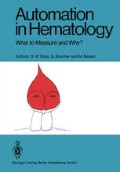Abstract
Laboratory test results and procedures can be evaluated at four levels:
-
1.
Analytic analysis of laboratory test: precision, technical sensitivity, technical specificity;
-
2.
Diagnostic analysis of laboratory test: diagnostic sensitivity, diagnostic specificity, Youden index, likelihood ratio, etc.;
-
3.
Operational analysis of laboratory test: predictive value of positive result, predictive value of negative result, efficiency, discriminant function, etc.;
-
4.
Medical decision-making analysis of laboratory test: threshold probability, cost-benefit analysis, solving the decision tree.
Analysis of results or selection of tests can occur at any level, without knowledge of the test’s evaluation or performance at the remaining levels. Alternately, the development of new laboratory tests can proceed from level 1 to level 4, or vice versa. Unfortunately, the former is usually the case and most of the tests in use today have never been evaluated at the medical decision-making level (level 4). Recent efforts at developing automated WBC differential counters represent a disproportionate amount of time and energy expended at level 1, and typify our backward approach to laboratory medicine. In thinking about the development of new diagnostic tests, we should begin at level 4 to characterize the properties and specifications that the test must meet. As an example, an in vitro test for the diagnosis of pulmonary embolism could be characterized in this fashion with criteria specified at each of the lower levels.
Returning to the question of “How good should a laboratory test be?”, we can see that the answer must come from an analysis of the benefit-cost equation (level 4). Figure 2 is a plot of the net benefit and cost of treatment versus the threshold probability. Since the threshold probability defines how certain one must be of the diagnosis before proceeding with treatment, it serves as a minimum probability which should be exceeded by the predictive value of the test.
When the benefit-cost ratio is low, a test with a very high predictive value is required to exceed the threshold probability. On the other hand, when the benefit-cost ratio is high, even a test with a low predictive value would be of use to the physician in making the decision to treat the patient. Within this framework, a number of clinical situations could be evaluated and problems requiring the development of highly predictive laboratory tests (low benefit-cost ratios) could be identified. Too much emphasis in laboratory medicine has been placed on the “laboratory” and not enough on the “medicine”. How important is the coefficient of variation when the benefit-cost ratio is high? Tests can not be developed or selected appropriately in a therapeutic vacuum.
Access this chapter
Tax calculation will be finalised at checkout
Purchases are for personal use only
Preview
Unable to display preview. Download preview PDF.
References
AMENTA, J.S., HARKINS, M.L.: The use of discriminant functions in laboratory medicine: Evaluation of phosphate clearance and studies in the diagnosis of hyperparathyroidism. Am. J. Clin. Pathol. 55, 330–341, 1971
BECK, J.R.B., CORNWELL, G.G., RAWNSLEY, H.M.: Multivariate approach to predictive diagnosis of bone marrow iron stores. Am. J. Clin. Pathol. 70, 665–670, 1978
BENSON, E.S.: The concept of the normal range. Hum. Pathol. 3, 152–155, 1972
DYBKAER, R., GRASBECK, R.: Theory of reference values. Scand. J. Lab. Invest. 32, 1–7, 1973
GALEN, R.S., GAMBINO, S.R.: Beyond Normality − The Predictive Value and Efficiency of Medical Diagnoses. New York, John Wiley and Sons, 1975
GRAMS, R.R., JOHNSON, E.A., BENSON, E.S.: Laboratory data analysis system. 3. Multivariate normality. Am. J. Clin. Pathol. 58, 188–200, 1972
KLEE, G.G., ACKERMAN, E., ELVEBACK, L.R., etal.: Investigation of statistical decision rules for sequential hematologic laboratory tests. Am. J. Clin. Pathol. 69, 375–382, 1978
MURPHY, E.A.: The normal, and the perils of the sylleptic argument. Perspect. Biol. Med. 15, 566–583, 1971
MURPHY, E.A., Abbey, H.: The normal range − a common misuse. J. Chronic Dis. 20, 79–88, 1967
PAUKER, S.G., KASSIRER, J.P.: Therapeutic decision making: A cost-benefit analysis. N. Engl. J. Med. 293, 229–234, 1975
RAMSOE, K., TYGESTRUP, N., WINKEL, P.: The redundancy of liver tests in the diagnosis of cirrhosis estimated by multivariate statistics. Scand. J. Clin. Lab. Invest. 26, 307–312, 1970
SUNDERMAN, F.W., Jr.: Current concepts of “normal values”, “reference values” and “discrimination values” in clinical chemistry. Clin. Chem. 21, 1873–1877, 1975
WINKEL, P.: Patterns and clusters − multivariate approach for interpreting clinical-chemistry results. Clin. Chem. 19, 1329–1338, 1973
STENGLE, J.M.: Diurnal-nocturnal variations of certain blood constituents in normal human subjects: Plasma iron, siderophilin, bilirubin, copper, total serum protein and albumin, hemoglobin and hematocrit. Br. J. Haematol. 3, 117, 1957
Author information
Authors and Affiliations
Editor information
Editors and Affiliations
Rights and permissions
Copyright information
© 1981 Springer-Verlag Berlin Heidelberg
About this paper
Cite this paper
Galen, R.S. (1981). Predictive Value and Efficiency of Hematology Data. In: Ross, D.W., Brecher, G., Bessis, M. (eds) Automation in Hematology. Springer, Berlin, Heidelberg. https://doi.org/10.1007/978-3-642-67756-4_8
Download citation
DOI: https://doi.org/10.1007/978-3-642-67756-4_8
Publisher Name: Springer, Berlin, Heidelberg
Print ISBN: 978-3-540-10225-0
Online ISBN: 978-3-642-67756-4
eBook Packages: Springer Book Archive

